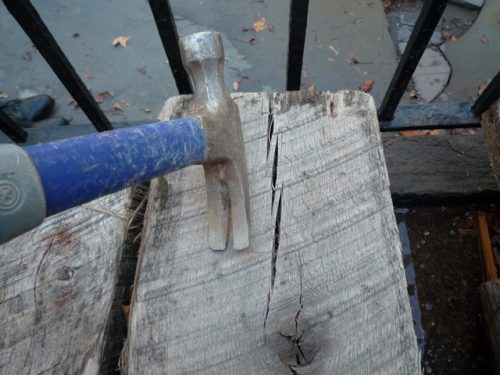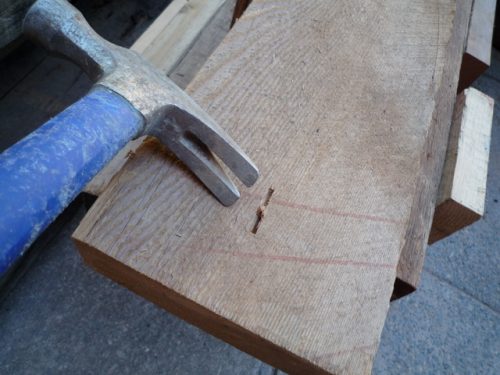I had a big argument with my architect because I wanted to use salvaged wood for part of the house and his mantra was:
“If it is fixing something old you can use it but if you are building something new you need to use new wood.”
Fixing some broken joists in a floor is ok to use old wood. Make a new floor and you have to use new wood.
This drives me crazy. Here is why.
Below are three types of wood. Two are salvaged and more than 100 years old. One is brand new fresh off the mountain. The department of buildings will let me use the new wood but not the old wood, presumably because the old wood is inferior.
Here I have described how I have tested the three types of woods by a simple hammer:
Hammer Test With old yellow pine Wood

The first one I hit is real 8″x8″ old yellow pine beams. The hammer bounced off without leaving even a dent. It hurt my wrist and felt like I was hitting concrete. This beam costs less than the equivalent sized new wood. I bought it from the wood salvage place Fine Lumber. It is over 100 years old and has several hundred to go.
2nd Hammer Test I have done with Douglass Fir Wood

The second type of wood is salvaged real size 3″ x 8″ fir. It is also about 100 years old. The hammer made a dent but didn’t stick in. This wood was free but you can buy it at Fine lumber for about the same as the equivalent size new wood.
Third Test Was Done With New Pine Beam and The Hammer

The third wood is a 2″ x 10″ new pine beam. This is what I ended up using because I didn’t want any issues with the DOB. My project is strange enough with all the green stuff I’m doing. I need to make sure it is all code. The hammer stuck in the wood completely. Compared to the other two woods it was like hitting sponge cake. Here it is. I pulled the hammer out to show the hole.
The moral of the story? When used ethically old wood is the way to go. It saves landfill, saves trees, is stronger, costs the same or less, obviously lasts a lot longer and doesn’t feel like spongecake.
